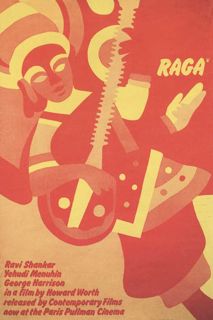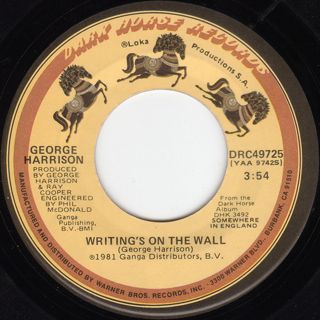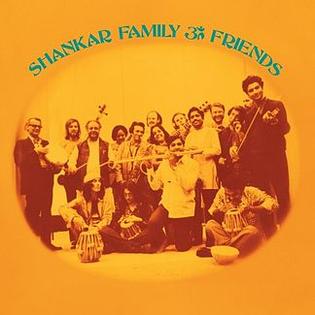
The Concert for Bangladesh was a pair of benefit concerts organised by former Beatles guitarist George Harrison and Indian sitar player Ravi Shankar. The shows were held at 2:30 and 8:00 pm on Sunday, 1 August 1971, at Madison Square Garden in New York City, to raise international awareness of, and fund relief for refugees from East Pakistan, following the Bangladesh Liberation War-related genocide. The concerts were followed by a bestselling live album, a boxed three-record set, and Apple Films' concert documentary, which opened in cinemas in the spring of 1972.

Dark Horse Records is a record label founded by former Beatle George Harrison in 1974. The label's formation coincided with the winding down of the Beatles' Apple Records and allowed Harrison to continue supporting other artists' projects while maintaining his solo career. The initial signings were Indian musician Ravi Shankar and Splinter, the latter of whom provided the label with its only significant commercial success until Harrison himself signed with Dark Horse in 1976. The label was distributed internationally by A&M Records for the first two years of its operation. Following a highly publicised split with A&M, Harrison and Dark Horse formed a long-term partnership with Warner Bros. Records that lasted until the expiration of his contract in 1994.

Wonderwall Music is the debut solo album by English musician George Harrison and the soundtrack to the 1968 film Wonderwall, directed by Joe Massot. Released in November 1968, it was the first solo album by a member of the Beatles, and the first album issued on the band's Apple record label. The songs are all instrumental pieces, except for occasional non-English language vocals, and mostly comprise short musical vignettes. Following his Indian-styled compositions for the Beatles since 1966, he used the film score to further promote Indian classical music by introducing rock audiences to instruments that were relatively little-known in the West – including shehnai, sarod, tar shehnai, tanpura and santoor. The Indian pieces are contrasted by Western musical selections, in the psychedelic rock, experimental, country and ragtime styles.
"The Day the World Gets 'Round" is a song by English musician George Harrison, released on his 1973 album Living in the Material World. Harrison was inspired to write the song following the successful Concert for Bangladesh shows, which were held in New York on 1 August 1971 as a benefit for refugees from the country formerly known as East Pakistan. The lyrics reflect his disappointment that such a humanitarian aid project was necessary, given the abundance of resources available across the planet, and his belief that if all individuals were more spiritually aware, there would be no suffering in the world. Adding to Harrison's frustration while writing the song, the aid project became embroiled in financial problems, as commercial concerns delayed the release of the Concert for Bangladesh album, and government tax departments failed to embrace the goodwill inherent in the venture.
"The Lord Loves the One (That Loves the Lord)" is a song by English rock musician George Harrison, released on his 1973 album Living in the Material World. Like the album's title track, it was inspired by the teachings of A.C. Bhaktivedanta Swami Prabhupada, founder of the International Society for Krishna Consciousness (ISKCON), more commonly known as the Hare Krishna movement. The song is an uptempo rock track with elements of blues and gospel. Some commentators have described it as the musical highpoint of Living in the Material World, with Harrison's slide guitar playing singled out as being among the finest performances of his career.

Raga is a 1971 documentary film about the life and music of Indian sitarist Ravi Shankar, produced and directed by Howard Worth. It includes scenes featuring Western musicians Yehudi Menuhin and George Harrison, as well as footage of Shankar returning to Maihar in central India, where as a young man he trained under the mentorship of Allauddin Khan. The film also features a portion of Shankar and tabla player Alla Rakha's acclaimed performance at the 1967 Monterey Pop Festival.
John Barham is an English classical pianist, composer, arranger, producer and educator. He is best known for his orchestration of George Harrison albums such as All Things Must Pass (1970) and for his association with Indian sitar maestro Ravi Shankar.

"Hari's on Tour (Express)" is an instrumental by English musician George Harrison, released as the opening track of his 1974 album Dark Horse. It was also the B-side of the album's second single – which was "Ding Dong, Ding Dong" in North America and most other territories, and "Dark Horse" in Britain and some European countries. Among Harrison's post-Beatles solo releases, the track is the first of only two genuine instrumentals he released from 1970 onwards – the other being the Grammy Award-winning "Marwa Blues", from his 2002 album Brainwashed.
"It Is 'He' " is a song by English musician George Harrison, released as the final track of his 1974 album Dark Horse. Harrison was inspired to write the song while in the Hindu holy city of Vrindavan, in northern India, with his friend Ravi Shankar. The composition originated on a day that Harrison describes in his autobiography as "my most fantastic experience", during which his party and their ascetic guide toured the city's temples. The song's choruses were adapted from the Sanskrit chant they sang before visiting Seva Kunj, a park dedicated to Krishna's childhood. The same pilgrimage to India led to Harrison staging Shankar's Music Festival from India in September 1974 and undertaking a joint North American tour with Shankar at the end of that year.

"Writing's on the Wall" is a song by English musician George Harrison from his 1981 album Somewhere in England. It was also the B-side of the album's lead single, "All Those Years Ago", which Harrison wrote as a tribute to his former Beatles bandmate John Lennon. In his lyrics, Harrison sings of the transient nature of life and the importance of recognising a spiritual purpose. Although the song was written long before Lennon's murder in New York in December 1980, the lyrics' reference to how easily friends can be shot down and killed led listeners to interpret it as a further comment on Lennon's death.

Shankar Family & Friends is an album by Indian musician Ravi Shankar, recorded primarily in Los Angeles during the spring of 1973, but not released until late 1974. It was produced by Shankar's friend George Harrison and one of the first releases on the ex-Beatle's Dark Horse label. Out of print for many years, and much sought after as a result, the album was remastered in 2010 and reissued as part of the Ravi Shankar–George Harrison box set Collaborations.

Ravi Shankar's Music Festival from India was an Indian classical music revue led by sitarist and composer Ravi Shankar intended for Western concert audiences and performed in 1974. Its presentation was the first project undertaken by the Material World Charitable Foundation, set up the previous year by ex-Beatle George Harrison. Long a champion of Indian music, Harrison also produced an eponymous studio album by the Music Festival orchestra, which was released in 1976 on his Dark Horse record label. Both the CD format of the Ravi Shankar's Music Festival from India album and a DVD of their performance at the Royal Albert Hall in London were issued for the first time on the 2010 Shankar–Harrison box set Collaborations.
The Material World Charitable Foundation, also known as the Material World Foundation (MWF), is a charitable organisation founded by English musician George Harrison in April 1973. Its launch coincided with the release of Harrison's album Living in the Material World and came about in reaction to the taxation issues that had hindered his 1971–72 aid project for refugees of the Bangladesh Liberation War. Harrison assigned his publishing royalties from nine of the eleven songs on Living in the Material World, including the hit single "Give Me Love ", to the foundation, in perpetuity.

"I Am Missing You" is a song by Indian musician Ravi Shankar, sung by his sister-in-law Lakshmi Shankar and released as the lead single from his 1974 album Shankar Family & Friends. The song is a rare Shankar composition in the Western pop genre, with English lyrics, and was written as a love song to the Hindu god Krishna. The recording was produced and arranged by George Harrison, in a style similar to Phil Spector's signature sound, and it was the first single issued on Harrison's Dark Horse record label. Other contributing musicians include Tom Scott, Nicky Hopkins, Billy Preston, Ringo Starr and Jim Keltner. A second version appears on Shankar Family & Friends, titled "I Am Missing You (Reprise)", featuring an arrangement closer to a folk ballad.

Joi Bangla is an EP by Indian sitar virtuoso Ravi Shankar, issued in August 1971 on Apple Records. The recording was produced by George Harrison and its release marked the first in a series of occasional collaborations between the two musicians that lasted until the Chants of India album in 1997. Shankar recorded the EP in Los Angeles, to help raise international awareness of the plight faced by refugees of the Bangladesh Liberation War, in advance of his and Harrison's Concert for Bangladesh shows at Madison Square Garden, New York. Side one of the disc consists of two vocal compositions sung in Bengali, of which the title track was a message of unity to the newly independent nation, formerly known as East Pakistan. The third selection is a duet by Shankar and sarodya Ali Akbar Khan, supported by Alla Rakha on tabla, a performance that presaged their opening set at the Concert for Bangladesh.

George Harrison and Ravi Shankar's 1974 North American tour was a 45-show concert tour of the United States and Canada, undertaken by English musician George Harrison and Indian sitarist Ravi Shankar in November and December 1974. It is often referred to as the Dark Horse Tour, since the concerts served as a launch for Harrison's record label Dark Horse Records, to which Shankar was one of the inaugural signings, and Harrison's concurrent single was the song "Dark Horse". The release of his delayed album, also titled Dark Horse, followed towards the end of the tour. The shows featured guest spots by Harrison's band members Billy Preston and Tom Scott.

Ravi Shankar: In Celebration is a compilation box set by Indian classical musician and composer Ravi Shankar, released in 1996 on Angel Records in conjunction with Dark Horse Records. The four discs cover Shankar's international career, from the 1950s to the mid 1990s, and include recordings originally released on the World Pacific, HMV, Angel, Apple, Dark Horse and Private Music record labels. Shankar's friend George Harrison compiled and co-produced the set, which was issued as part of year-long celebrations for Shankar's 75th birthday.
"Ride Rajbun" is a song by English musician George Harrison. It was released in 1992 on the multi-artist charity album The Bunbury Tails, which was the soundtrack to the British animated television series of the same name. Harrison co-wrote the song's lyrics with Bunbury Tails creator David English. The eponymous Rajbun was a character in the series based on English's friend and cricketer Rajendrasinh Jadeja, one of a team of cricket-playing rabbits – in this case, from Bangalore in India. The composition is in the style of a nursery rhyme or children's song, while the all-Indian instrumentation on the recording recalls some of Harrison's compositions for the Beatles during 1966–68.

Collaborations is a four-disc compilation box set by Indian classical musician Ravi Shankar and former Beatle George Harrison. Released in October 2010 on Dark Horse Records, it compiles two studio albums originally issued on that label – the long-unavailable Shankar Family & Friends (1974) and Ravi Shankar's Music Festival from India (1976) – and Chants of India, first issued on Angel Records in 1997. Although all three albums were originally Shankar releases, for which Harrison served in the role of music producer and guest musician, both Shankar and Harrison are credited as artists on the box set. Each of the collaborative projects represents a departure from Shankar's more typical work as a sitarist and performer of Hindustani classical ragas, with the box set showcasing his forays into, variously, jazz and rock, Indian folk and orchestral ensembles, and devotional music.

Raga Mala is an autobiographic work by Indian classical musician Ravi Shankar, published in 1997 as a hand-bound, limited edition book by Genesis Publications. The initial print run was limited to 2000 signed and individually numbered copies, with a foreword by George Harrison, who also served as Shankar's editor. In addition, Oliver Craske was credited with providing "additional narrative".














